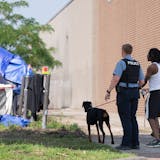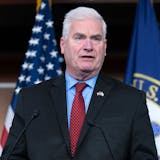After a night of partying at a downtown Minneapolis nightclub, Sir Knox ushered his friends out a few minutes before 2 a.m., looking to avoid the problems that can come around bar closing time.
But suddenly, two men began shooting at each other on the crowded sidewalk.
As friends took off running, Knox yelled, "Get down!" before hitting the ground. He saw a young man sprint past him and then fall. When the gunfire quieted, Knox looked up to see the man on the pavement a few feet away, fatally wounded. He would later be identified as 21-year-old University of St. Thomas student Charlie Johnson, who was just hours from graduating.
Shaken by the tragedy, Knox, 29, an Edina mail carrier, said he's thankful the bullets missed him and his friends, "and that we're breathing and that we love each other."
Johnson was one of two people killed in the May 22 shootout — the other was Christopher Jones, 23, who police say was the intended target and shot back in self-defense. Eight others were wounded. The man accused of starting the gunfire faces multiple counts of murder and attempted murder. More shots broke out near the North Side church that held a memorial service for Jones, killing one man and wounding another.
As Minneapolis struggles to develop a new approach to public safety amid intense scrutiny of its Police Department, it faces a depressingly familiar problem: how to curb surging violence as the weather warms.
As of Thursday, the city had 273 gunshot victims and 43 homicides so far this year, mostly by gunfire. Overnight Friday, five more people were shot and wounded in Dinkytown.
Mayor Jacob Frey and other city leaders say they are focused on reducing crime during the summer months, deploying teams of violence intervention workers and bringing in outside law enforcement help to boost the depleted police force, down by one-third since George Floyd's murder last year. Others worry that officials are going back on their pledge to radically reimagine public safety. The answer, they say, is funding affordable housing, health initiatives and other services supporting communities of color, not more cops.

